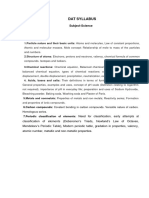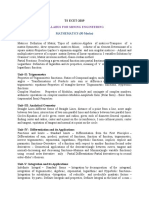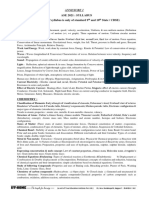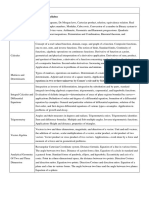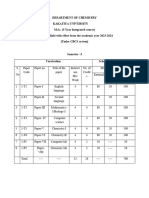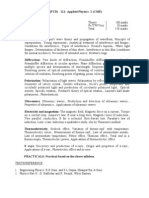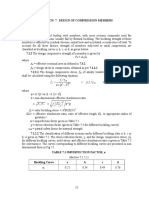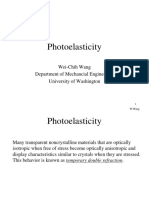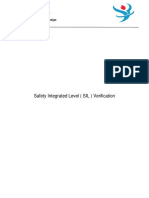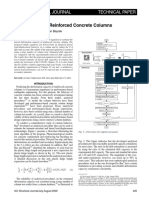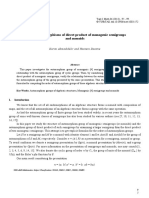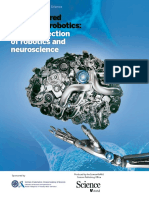NDA & NA Examination I & II Syllabus 2020 (1)
Uploaded by
r.n.spamfolderNDA & NA Examination I & II Syllabus 2020 (1)
Uploaded by
r.n.spamfolderNational Defence Academy & Naval Academy Examination (I) & (II) Syllabus 2020.
SYLLABUS OF THE EXAMINATION
PAPER – I
MATHEMATICS
(Code No. 1)
(Maximum Marks – 300)
1. ALGEBRA
Concept of set, operations on sets, Venn diagrams. De Morgan laws, Cartesian product, relation,
equivalence relation.
Representation of real numbers on a line. Complex numbers – basic properties, modulus,
argument, cube roots of unity. Binary system of numbers. Conversion of a number in decimal
system to binary system and vice-versa. Arithmetic, Geometric and Harmonic progressions.
Quadratic equations with real coefficients. Solution of liner inequations of two variables by graphs.
Permutation and Combination. Binomial theorem and its applications. Logarithms and their
m
applications.
2. MATRICES AND DETERMINANTS :
co
Types of matrices, operations on matrices. Determinant of a matrix, basic properties of
determinants. Adjoint and inverse of a square matrix, Applications-Solution of a system of linear
a.
equations in two or three unknowns by Cramer's rule and by Matrix Method.
di
3. TRIGONOMETRY :
rin
Angles and their measures in degrees and in radians. Trigonometrical ratios. Trigonometric
identities Sum and difference formulae. Multiple and Sub-multiple angles. Inverse trigonometric
functions. Applications-Height and distance, properties of triangles.
e
4. ANALYTICAL GEOMETRY OF TWO AND THREE DIMENSIONS :
re
Rectangular Cartesian Coordinate system. Distance formula. Equation of a line in various forms.
Angle between two lines. Distance of a point from a line. Equation of a circle in standard and in
a
general form. Standard forms of parabola, ellipse and hyperbola. Eccentricity and axis of a conic.
.c
Point in a three dimensional space, distance between two points. Direction Cosines and direction
ratios. Equation two points. Direction Cosines and direction ratios. Equation of a plane and a line in
w
various forms. Angle between two lines and angle between two planes. Equation of a sphere.
5. DIFFERENTIAL CALCULUS :
w
Concept of a real valued function-domain, range and graph of a function. Composite functions,
w
one to one, onto and inverse functions. Notion of limit, Standard limits – examples. Continuity of
functions – examples, algebraic operations on continuous functions. Derivative of function at a
point, geometrical and physical interpretation of a derivative-applications. Derivatives of sum,
product and quotient of functions, derivative of a function with respect to anothe function,
derivative of a composite function. Second order derivatives. Increasing and decreasing functions.
Application of derivatives in problems of maxima and minima.
6. INTEGRAL CALCULUS AND DIFFERENTIAL EQUATIONS:
Integration as inverse of differentiation, integration by substitution and by parts, standard
integrals involving algebraic expressions, trigonometric, exponential and hyperbolic functions.
Evaluation of definite integrals – determination of areas of plane regions bounded by curves –
applications. Definition of order and degree of a differential equation, formation of a differential
equation by examples. General and particular solution of adifferential equations, solution of first
order and first degree differential equations of various types – examples. Application in problems of
growth and decay.
7. VECTOR ALGEBRA:
Vectors in two and three dimensions, magnitude and direction of a vector. Unit and null vectors,
addition of vectors, scalar multiplication of a vector, scalar product or dot product of two vectors.
Vector product or cross product of two vectors. Applications – work done by a force and movement
of a force and in geometrical problems.
8. STATISTICS AND PROBABILITY :
m
Statistics : Classification of data, Frequency distribution, cumulative frequency distribution –
examples. Graphical representation – Histogram, Pie Chart, frequency polugon – examples.
co
Measures of Central tendency – Mean, median and mode. Variance and standard deviation –
determination and comparison. Correlation and regression.
a.
Probability : Random experiment, outcomes and associated sample spaces, events, mutually
exclusive and exhaustive events, impossible and certain events. Union and intersection of events.
di
Complementary, elementary and composite events. Definition of probability – Classical and
Statistical – examples. Elementary theorems on probability – simple problems. Conditional
rin
probability, Bayes' theorem – simple problems. Random variable as function on a sample space.
Binomial distribution, examples of random experiments giving rise to Binominal distribution.
PAPER – II
e
GENERAL ABILITY TEST
re
(Code No. 02)
(Maximum Marks – 600)
a
Part 'A' – ENGLISH (Maximum Marks – 200)
.c
The question paper in English will be designed to test the candidate's understanding of English
w
and workman like use of words. The syllabus covers various aspects like : Grammar and usage,
vocabulary, comprehension and cohesion in extended text to test the candidate's proficiency in
English.
w
Part 'B' – GENERAL KNOWLEDGE (Maximum Marks – 200)
w
The question paper on General Knowledge will boardly cover the subjects : Physics, Chemistry,
General Science, Social Studies, Geography and Current Events.
The syllabus given below is designed to indicate the scope of these subjects included in this
paper. The topics mentioned are not to be regarded as exhaustive and questions on topics of similar
nature not specifically mentioned in the syllabus may also be asked. Candidate's answers are
expected to show their knowledge and intelligent understanding of the subject.
Section 'A' (Physics)
Physical Properties and State of Matter, Mass, Weight, Volume, Density and Specific Gravity,
Principle of Archimedes, Pressure Barometer.
Mation of objects, Velocity and Acceleration, Newton's Laws of Motion, Force and Momentum,
Parallelogram of Forces, Stability and Equilibrium of bodies, Gravitation, elementary ideas of work,
Power and Energy. Effects of Heat, Measurement of Temperature and Heat, Change of State and
Latent Heat, Modes of transference of Heat. Sound Waves and their properties, Simple musical
instruments. Rectilinear propagation of Light, Reflection and refraction. Spherical mirrors and
Lenses, Human Eye. Natural and Artificial Magnets, Properties of a Magnet, Earth as a Magnet.
Static and Current Electrictiy, conductors and Non-conductors, Ohm's Law, Simple Electrical
Circuits, Heating, Lighting and Magnetic effects of Current, Measurement of Electrical Power,
Primary and Secondary Cells, Use of X-Rays. General Principles in the working of the following :
Simple Pendulum, Simple Pulleys, Siphon, Levers, Balloon, Pumps, Hydrometer, Pressure
Cooker, Thermos Flask, Gramophone, Telegraphs, Telephone, Periscope, Telescope, Microscope,
Mariner's Compass; Lightening Conductors, Safety Fuses.
m
Section 'B' (Chemistry)
co
Physical and Chemical changes. Elements, Mixtures and Compounds, Symbols, Formulae and
simple Chemical Equations, Law of Chemical Combination (Excluding Problems). Properties of Air
and Water.
a.
Preparation and Properties of Hydrogen, Oxygen, Nitrogen and Carbondioxide, Oxidation and
di
Reduction. Acids, bases and salts. Carbon – different forms. Fertilizers – Natural and Artificial.
Material used in the preparation of substances like Soap, Glass, Ink, Paper, Cement, Paints, Safety
rin
Matches and Gun-Powder. Elementary ideas about the structure of Atom, Atomic Equivalent and
Molecular Weights, Valency.
Section 'C' (General Science)
e
re
Difference between the living and non-living. Basis of Life – Cells, Protoplasms and Tissues.
Growth and Reproduction in Plants and Animals.
Elementary knowledge of Human Body and its important organs. Common Epidemics, their causes
a
and prevention.
.c
Food – Source of Energy for man. Constituents of food, Balanced Diet. The Solar System – Meteors
w
and Comets, Eclipses. Achievements of Eminent Scientists.
Section 'D' (History, Freedom Movement etc).
w
A broad survey of Indian History, with emphasis on Culture and Civilisation.
w
Freedom Movement in India. Elementary study of Indian Constitution and Administration.
Elementary knowledge of Five Year Plans of India. Panchayati Raj, Co-operatives and Community
Development. Bhoodan, Sarvodaya, National Integration and Welfare State, Basic Teachings of
Mahatma Gandhi.
Forces Shaping the modern world; Renaissance, Exploration and Discovery; War of American
Independence. French Revolution, Industrial Revolution and Russian Revolution. Impace of
Science and Technology on Society. Concept of one World, United Nations, Panchsheel,
Democracy, Socialism and Communism. Role of India in the present world.
Section 'E' (Geography)
The Earth, its shape and size. Lattitudes and Longitudes, Concept of time. International Date
Line. Movements of Earth and their effects. Origin of Earth. Rocks and their classification;
Weathering – Mechanical and Chemical, Earthquakes and Volcanoes. Ocean Currents and Tides
Atmosphere and its composition; Temperature and Atmospheric Pressure, Planetary Winds,
Cyclones and Anti-cyclones; Humidity; Condensation and Precipitation; Types of Climate, Major
Natural regions of the world. Regional Geography of India – Climate, Natural Vegetation. Mineral
and Power resources; location and distribution of agricultural and Industrial activities. Important
Sea ports and main sea, land and air routes of India. Main items of Imports and Exports of India.
Section 'F' (Current Events)
Knowledge of Important events that have happened in India in the recent years. Current
important world events. Prominent personalities – both Indian and International including those
m
connected with cultural activities and sports.
NOTE : Out of maximum marks assigned to part 'B' of this paper, questions on Sections 'A', 'B'. 'C',
co
'D', 'E' and 'F' will carry approximately 25%, 15%, 10%, 20%, 20% and 10% weightages
respectively.
a.
Intelligence and Personality Test.
di
The SSB procedure consists of two stage selection process – Stage I and Stage II. Only those
candidates who clear the stage I are permitted to appear for Stage II. The details are :
rin
(A) Stage I comprises of Officer Intelligence Rating (OIR) tests are Picture Perception *
Description Test (PP&DT). The Candidates will be shortlisted based on combination of
performance in OIR Test and PP&DT.
e
re
(B) Stage II Comprises of Interview, Group Testing Officer Tasks, Psychology Tests and the
Conference. These tests are conducted over 4 days. The details of these tests are given on the
website joinindianarmy.nic.in.
a
.c
The personality of a candidate is assessed by three different assessors viz. The Interviewing
Officer (IO), Group Testing Officer (GTO) and the Psychologist. There are no separate weightage
w
for each test. The mks are allotted by assessors only after taking into consideration the performance
of the candidate holistically in all the test. In addition, marks for Conference are also allotted based
on the initial performance of the Candidate in the three technique and decision of the Board. All
w
these have equal weightage.
w
The various tests of IO, GTO and Psych are designed to bring out the presence / absence of
Officer Like Qualities and their trainability in a candidate. Accordingly candidates are
Recommended or Not Recommended at the SSB.
You might also like
- Research Methodology: Methods and Techniques100% (1)Research Methodology: Methods and Techniques26 pages
- NDA & NA Exam (I) & (II) - Syllabus 2021No ratings yetNDA & NA Exam (I) & (II) - Syllabus 20216 pages
- SchemeSyllabus For Industrial Promotion OfficerNo ratings yetSchemeSyllabus For Industrial Promotion Officer9 pages
- Deck-Online-Entrance-Test-and-Interview (1)No ratings yetDeck-Online-Entrance-Test-and-Interview (1)2 pages
- Circular - Regarding PTs (IOQM, IAPT & NSEJS)No ratings yetCircular - Regarding PTs (IOQM, IAPT & NSEJS)2 pages
- Ase 2021: Syllabus (The Scope of Syllabus Is Only of Standard 9 and 10 State / CBSE) PhysicsNo ratings yetAse 2021: Syllabus (The Scope of Syllabus Is Only of Standard 9 and 10 State / CBSE) Physics2 pages
- Rajasthan Public Service Commission, Ajmer Scheme & Syllabus For The Post of Headmaster Competitive Exam, 2018 Secondary Education Department Syllabus of ExaminationNo ratings yetRajasthan Public Service Commission, Ajmer Scheme & Syllabus For The Post of Headmaster Competitive Exam, 2018 Secondary Education Department Syllabus of Examination7 pages
- Class - X (Unit Test Syllabus & Routine) pdf copyNo ratings yetClass - X (Unit Test Syllabus & Routine) pdf copy3 pages
- Syllabus For The Entrance Examinations 1. Mathematics For Admission To M.Sc. (Applied Mathematics)No ratings yetSyllabus For The Entrance Examinations 1. Mathematics For Admission To M.Sc. (Applied Mathematics)5 pages
- Jawahar Navodaya Class 11 Entrance Exam Syllabus in PDF For 2025 26No ratings yetJawahar Navodaya Class 11 Entrance Exam Syllabus in PDF For 2025 268 pages
- Hindu News Analysis 21-06-2023 - 230621 - 190644No ratings yetHindu News Analysis 21-06-2023 - 230621 - 19064452 pages
- IOE Entrance Syllabus and Sample QuestionNo ratings yetIOE Entrance Syllabus and Sample Question6 pages
- Syllabus: Compulsory General Aptitude Basic Knowledge in Physics, Mathematics, Chemistry and Biology at 10 +No ratings yetSyllabus: Compulsory General Aptitude Basic Knowledge in Physics, Mathematics, Chemistry and Biology at 10 +5 pages
- 1048 - M - SC (5 Yr - Int - ) Chemistry Revised SyllabusNo ratings yet1048 - M - SC (5 Yr - Int - ) Chemistry Revised Syllabus48 pages
- Paper-I Mathematics (Maximum Marks - 300)No ratings yetPaper-I Mathematics (Maximum Marks - 300)2 pages
- JMI School Entrance Test (Class 6, 9 and 11)No ratings yetJMI School Entrance Test (Class 6, 9 and 11)13 pages
- Syllabus For Mechanical Engineering: TS ECET-2019No ratings yetSyllabus For Mechanical Engineering: TS ECET-20198 pages
- SSC Scientific Assistant IMD Syllabus 2022 PDFNo ratings yetSSC Scientific Assistant IMD Syllabus 2022 PDF6 pages
- Barron's Physics Practice Plus: 400+ Online Questions and Quick Study ReviewFrom EverandBarron's Physics Practice Plus: 400+ Online Questions and Quick Study ReviewNo ratings yet
- Financial Literacy and Portfolio DynamicsNo ratings yetFinancial Literacy and Portfolio Dynamics34 pages
- Time Series Models For Business and Economic Forecasting: Second Edition Philip Hans Franses, Dick Van Dijk and Anne OpschoorNo ratings yetTime Series Models For Business and Economic Forecasting: Second Edition Philip Hans Franses, Dick Van Dijk and Anne Opschoor12 pages
- MBA-BUSINESS RESEARCH METHODS - Important Questions - Doc - 20241127 - 105353 - 0000No ratings yetMBA-BUSINESS RESEARCH METHODS - Important Questions - Doc - 20241127 - 105353 - 00003 pages
- (eBook PDF) The Analysis of Time Series: An Introduction with R 7th Edition instant download100% (4)(eBook PDF) The Analysis of Time Series: An Introduction with R 7th Edition instant download45 pages
- Drift Capacity of Reinforced Concrete Columns: Aci Structural Journal Technical PaperNo ratings yetDrift Capacity of Reinforced Concrete Columns: Aci Structural Journal Technical Paper11 pages
- On The Automorphisms of Direct Product of Monogenic Semigroups and MonoidsNo ratings yetOn The Automorphisms of Direct Product of Monogenic Semigroups and Monoids5 pages
- Lesson 4 For Tuesday, January 05, 2010 Creating RelationshipsNo ratings yetLesson 4 For Tuesday, January 05, 2010 Creating Relationships5 pages
- Brain Inspired Robotics Supplement FinalNo ratings yetBrain Inspired Robotics Supplement Final56 pages
- Interest Rate Models. Damir Filipović University of MunichNo ratings yetInterest Rate Models. Damir Filipović University of Munich69 pages





















